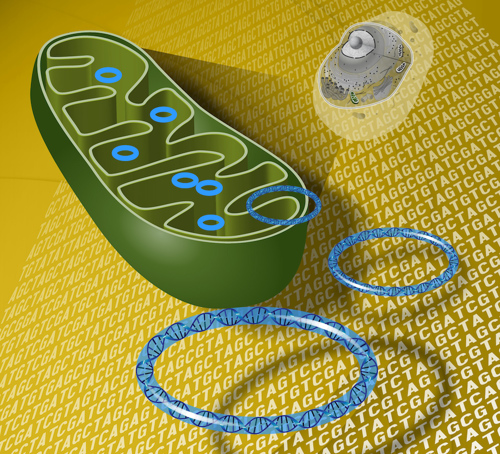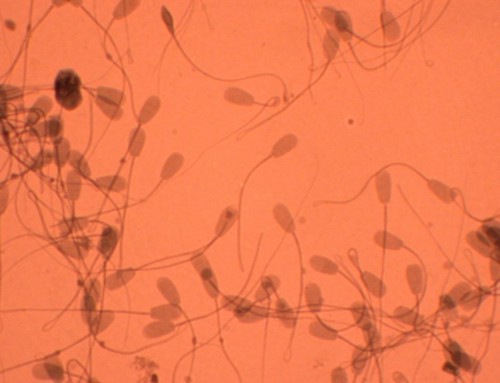
What is the story with mitochondrial DNA?
March 9, 2006

- Related Topics:
- Cell biology,
- Evolution,
- Mitochondria
A curious adult from Maine asks:
"What is the story with this other kind of DNA--mitochondrial DNA? Is it true that only mothers pass it down? Does it have effects on children? In what way? Oh, and where is it?"
Mitochondrial DNA (mtDNA) is a cool relic from our evolutionary past. Instead of just two copies per cell like our chromosomes, our cells have many more copies of mtDNA.
And unlike the rest of our DNA, mtDNA is found outside of the nucleus. It also passes from mom to kids; you don’t inherit any from your dad!
This weird DNA is found in little compartments in our cells called mitochondria. A mitochondrion's job is to make energy for the cell. Why would the cell's "powerhouse" have its own DNA?
Because it used to be a creature living on its own. Scientists think that a long time ago, our ancestors absorbed the mitochondrion's ancestor. Working together, this duo took over the world.
But in the process, the mitochondria took a beating. Most of their DNA is now found in the nucleus of the host cell (although different species have mitochondria with differing amounts of DNA). The mitochondria can no longer live on its own -- it is a hollow shell of what it once was.

And this hollow shell passes only from mother to child. Of course dad has mitochondria too, but for a couple of reasons kids almost never get them from him.
The first reason is that the egg is way bigger than the sperm meaning that it has a whole lot more mitochondria. This means that when the egg and sperm combine, the egg's mitochondria swamp out the sperm's.
But this isn't good enough for the egg. The egg actually marks sperm mitochondria for destruction and gets rid of them. The end result of all of this is that we get our mtDNA exclusively from our mothers.
So is this DNA important for anything? It sure is. If the DNA gets damaged, the mitochondria don't work as well. And when the mitochondria don't work right, all sorts of problems can result.
There are some diseases that come from having mitochondria with damaged DNA. And some infertility problems are the result of eggs with bad mtDNA.
It’s possible to get around this problem with a nifty new technique called mitochondrial replacement therapy. In fact, some babies have been born that have mtDNA from one woman and nuclear DNA from mom and dad! (Click here to learn more.)
And the biggest problem of all is getting older. Many of the problems associated with getting old result from damage to our mtDNA. How's that for important!

Scientists think that one of the big reasons we begin to break down as we get older is that our mtDNA gets beat up over the years. The mtDNA isn't as good at fixing itself as nuclear DNA and it takes more of a beating in its job. Making energy makes free radicals which damages DNA. (So eat your anti-oxidants!)
Nice theory but is there any proof? Actually, some scientists did a wonderful experiment a couple of years back that showed that part of getting old comes from mtDNA damage. At least in mice.
In the experiment, these scientists created a mouse that made lots of mistakes whenever it copied its mtDNA. They reasoned that if mtDNA damage was a big part of aging, then this mouse should get old earlier. And they were right.
At about 25 weeks of age, the mutant mice started to show signs of aging that are normally seen in much older mice. The mutant mice lived for less than a year instead of for 2 to 3 years. All because of damage to their mtDNA.
Wouldn't it be cool if they made a mouse that made fewer mistakes than normal? Or that could more easily fix any mistakes that are being made? Then they could test if that mouse lives longer than normal, with fewer signs of aging. Finally a fountain of youth.
Of course there is a lot more than mtDNA damage to aging so the mice wouldn't live forever. But even a few extra years would be wonderful...

Author: Dr. D. Barry Starr
Barry served as The Tech Geneticist from 2002-2018. He founded Ask-a-Geneticist, answered thousands of questions submitted by people from all around the world, and oversaw and edited all articles published during his tenure. AAG is part of the Stanford at The Tech program, which brings Stanford scientists to The Tech to answer questions for this site, as well as to run science activities with visitors at The Tech Interactive in downtown San Jose.
 Skip Navigation
Skip Navigation
